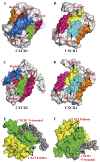The CXCL8-CXCR1/2 pathways in cancer
- PMID: 27578214
- PMCID: PMC6142815
- DOI: 10.1016/j.cytogfr.2016.08.002
The CXCL8-CXCR1/2 pathways in cancer
Abstract
Persistent infection or chronic inflammation contributes significantly to tumourigenesis and tumour progression. C-X-C motif ligand 8 (CXCL8) is a chemokine that acts as an important multifunctional cytokine to modulate tumour proliferation, invasion and migration in an autocrine or paracrine manner. Studies have suggested that CXCL8 and its cognate receptors, C-X-C chemokine receptor 1 (CXCR1) and C-X-C chemokine receptor 2 (CXCR2), mediate the initiation and development of various cancers including breast cancer, prostate cancer, lung cancer, colorectal carcinoma and melanoma. CXCL8 also integrates with multiple intracellular signalling pathways to produce coordinated effects. Neovascularisation, which provides a basis for fostering tumour growth and metastasis, is now recognised as a critical function of CXCL8 in the tumour microenvironment. In this review, we summarize the biological functions and clinical significance of the CXCL8 signalling axis in cancer. We also propose that CXCL8 may be a potential therapeutic target for cancer treatment.
Keywords: Angiogenesis; CXCL8; CXCR1; CXCR2; Cancer; Metastasis.
Copyright © 2016 The Authors. Published by Elsevier Ltd.. All rights reserved.
Conflict of interest statement
Competing financial interests: The authors declare no competing financial interests.
Figures


References
-
- Gulumian M, The role of oxidative stress in diseases caused by mineral dusts and fibres: current status and future of prophylaxis and treatment, Mol. Cell. Biochem 196 (1999) 69–77. - PubMed
-
- Balkwill F, Mantovani A, In ammation and cancer: back to Virchow, Lancet 357 (2001) 539–545. - PubMed
-
- Waugh DJ, Wilson C, The interleukin-8 pathway in cancer, Clin. Cancer Res 14 (2008) 6735–6741. - PubMed
-
- Hoffmann E, Dittrich-Breiholz O, Holtmann H, Kracht M, Multiple control of interleukin-8 gene expression, J. Leukoc. Biol 72 (2002) 847–855. - PubMed
Publication types
MeSH terms
Substances
Grants and funding
LinkOut - more resources
Full Text Sources
Other Literature Sources

